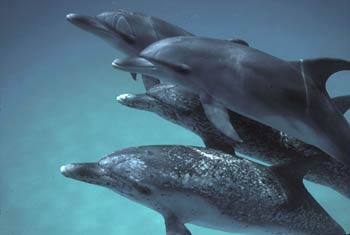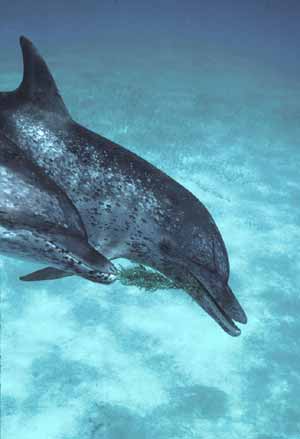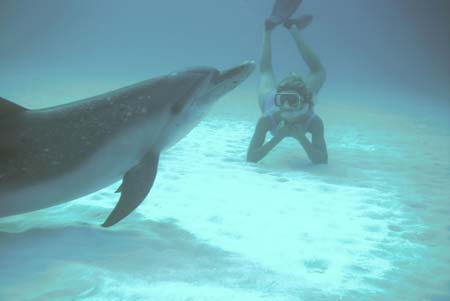 |
AQUATIC
CULTURE |
|
|
 |
 |
 |
 |
 |
Dolphins and the Possibility of Interspecies Communication
by Denise L. Herzing
In 1985 I began a long-term project in the Bahamas to observe and
study, underwater, a resident group of Atlantic spotted dolphins,
Stenella frontalis. Over the last 16 years we've recorded life history
information, communication (visual and postural) signals during
fighting, foraging, and play, and how mothers teach their calves
to hunt, fight, and babysit younger dolphins. The richness of behavior
we've observed over 16 years at sea speaks of a culture of intelligent
aquatic beings, with complex communication and flexible coping strategies
in the world. Dolphins are the aquatic equivalent of an advanced
terrestrial culture. Such observations reinforce the idea that perhaps
dolphins would be good candidates with the motivation to interact
with, and potentially communicate with humans.
The possibility of communicating with nonhuman animals has long
fascinated humans as long ago as Aristotle. Interspecies interaction,
specifically human/dolphin, is a very old phenomenon but a reemerging
field of scientific inquiry. The more we inquire into the lives
and minds of dolphins, and other toothed whales, the more we find
evidence of complex societies, communication, and cultures. Only
recently have we begun to search in the wild for such evidence and
opportunities to work. This interest stems from years of exploring
the possibilities of communication with other species, usually in
non-wild environments.
Our History Exploring Dolphin Communication
Many of our popular beliefs about dolphins come from the work and
writings of John Lilly. Originally a neurophysiologist with an interest
in the dolphin brain, Lilly began to understand that dolphins were
too intelligent to experiment on, and forged his own path to interspecies
communication. Although his later work remains controversial, many
of his original ideas remain intriguing. Lilly pursued a controversial
career, trying to teach dolphins English and matching vocal output
by the dolphins to humans. Although able to mimic the prosodic aspects
of human speech such as rhythm and intensity, the dolphins were
unable to produce consonants involved in the production of English
sounds, most likely due to the lack of necessary anatomy.
 Wild Dolphin
Project
Wild Dolphin
Project
A
mother and her calves.
|
Since Lilly's time a picture has emerged from long-term research
projects around the world. Ken Norris and his colleagues in Hawaii
have studied spinner dolphins, Stenella longirostris, Randall Wells
and his colleagues in Sarasota, Florida continue to study bottlenose
dolphins, Tursiops truncatus, and my ongoing work in the Bahamas
studying Atlantic spotted dolphins, Stenella frontalis. We know
many realistic aspects about life as a dolphin in the wild both
biologically and ecologically. But what will it really take to break
the code, to build a bridge between species, in this case an aquatic
mind evolved over a 30 million year old aquatic in a socially complex
environment?
What have we learned?
In captive settings, giving the dolphins control over the choice
of reinforcement and social interaction with nonhuman subjects has
been paramount in the investigation of interspecies communication.
Success has often been determined by the selection of the appropriate
sensory modality within which to communicate and work. Participatory
research, in combination with observations of a species natural
communication system, may be a fresh method of investigation available
to us.
 Wild Dolphin
Project
Wild Dolphin
Project
Playing
with sargassum, a favorite past-time.
|
We can see parallels from primate researchers over the years who
have focused on training their nonhuman subjects with artificially
derived codes. This mutual system of approach, or two way communication
methodology, has often been chosen because of the difficulty
of comparing and deciphering the complexities of nonhuman natural
systems.
Communicating with our nearest relatives.
In the history of work with captive primates there is a continuum
of methodologies researchers have used, from very objective and
strict, to more interactive, involving bonding with the animals
under study. One of the first studies, by David Premack, was a chimpanzee
named Sarah who was acquired from the wild. She was trained with
the use of a board, testing her ability to discriminate "same and
different" objects. Premack used an interrogative concept and remained
separate and "objective" during his work with Sarah. His work could
be considered on the far end of the continuum.
Duane and Sue-Savage Rumbaugh brought an interactive approach to
their work with two other chimpanzees, Sherman and Austin. The researchers
invested time developing rapport with Sherman and Austin, and also
tried to develop experiments that included referents or objects
that were important to chimpanzees themselves. Allowing Sherman
and Austin to work as a team, possibly mimicking the way communication
systems evolved under natural conditions, was also very successful.
In later years they started working with Kanzi, a pygmy chimpanzee,
the most closely related primate to humans. Using a portable keyboard
and a semi-natural environment, Kanzi is skilled at understanding
complex symbolic associations.
Another innovated approach to interspecies communication has been
the work with chimpanzee Washoe. The key to this work was trying
sign language, which Alex and Beatrice Gardner, and then Roger and
Debbie Fouts, believed was close to the chimpanzees' natural gestural
abilities. Washoe could express herself with gestures and
this proved the key to the interspecific communication between chimpanzees
and humans. Roger Fouts also reasoned that the chimpanzees would
be much more interested in working with humans if they liked them
and found them interesting. This would provide the social motivation
for expressing themselves, to communicate with someone they liked,
about something they desired or wanted to express. His study would
later document the spread of sign language from chimp to chimp,
without human intervention, as an example of cultural transmission
within the chimp society itself.
 Wild
Dolphin Project
Wild
Dolphin Project
Dolphin
mimicking a human posture.
|
Lessons about our approach!
Some of the controversies around nonhuman animal communication has
centered around the "Clever Hans" story. Clever Hans was a horse
that was taught to "count", among other skills, by his trainer.
When a psychologist observed this interaction, he noticed that the
trainer was giving Hans subtle cues, everything from face nods to
slight movements. Without these "cues", Hans could not perform properly.
When the "double blind" method, not allowing the trainer or experimenter
the knowledge of the answer, was applied to avoid the suspected
exchange of subtle cues from trainer to animal, Clever Hans could
not perform.
What does the Clever Hans phenomenon suggest about biological communication
in general? Could it be that these "cues" are information bits that
create complex communication in the first place? If so, then we
are asking nonhuman animals to do what we cannot; to be restricted
to one modality, such as gestural signs or acoustic cues, and learn
a multi-modal language that involves these exact subtle cues. This
perhaps, could be our biggest lesson about communication and might
result in the creation of a more interactive and functionally expressive
methodology for interspecies communication in the future.
Despite the continuum of methodologies in all primate interspecies
work, most researchers agree that creating rapport with nonhuman
subjects is critical to the animal's motivation for interacting
and expressing themselves. Other species are capable of interacting
and communicating on a variety of levels. Perhaps it is our human
challenge to develop methodologies and sensitize ourselves to the
motivation of other species to maximize our opportunity to make
a connection.
Perhaps the similarities we find between species may turn out
to be more critical than the differences. We might find levels
of mental and social continuity and convergence across social species
on our very own planet, Earth.
|
 |
 Denise
Herzing is Research Faculty in the Department of Biological Sciences
at Florida Atlantic University in Boca Raton Florida. As Research
Director of the Wild
Dolphin Project she has been studying free-ranging Atlantic spotted
dolphins in the Bahamas since 1985. Born in Minnesota, she eventually
migrated to Florida to engage in a long-term study of the underwater
world of dolphins. Specializing in the communication and behavior
of this species, she has published her work in scientific journals
including Marine Mammal Science, Aquatic Mammals, Journal of Mammalogy,
and the Canadian Journal of Zoology, and popular magazines and film
media including BBC Wildlife, National Geographic, Ocean Realms, and
DIscovery. Films include Dolphin Diaries (BBC), In the Wild: Dolphins
with Robin Williams, and Talking with Aliens (Pioneer Productions). Denise
Herzing is Research Faculty in the Department of Biological Sciences
at Florida Atlantic University in Boca Raton Florida. As Research
Director of the Wild
Dolphin Project she has been studying free-ranging Atlantic spotted
dolphins in the Bahamas since 1985. Born in Minnesota, she eventually
migrated to Florida to engage in a long-term study of the underwater
world of dolphins. Specializing in the communication and behavior
of this species, she has published her work in scientific journals
including Marine Mammal Science, Aquatic Mammals, Journal of Mammalogy,
and the Canadian Journal of Zoology, and popular magazines and film
media including BBC Wildlife, National Geographic, Ocean Realms, and
DIscovery. Films include Dolphin Diaries (BBC), In the Wild: Dolphins
with Robin Williams, and Talking with Aliens (Pioneer Productions). |
 |
 |
|
|
